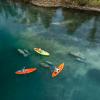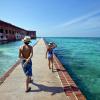By Terry Tomalin
Spending a few days in the wilderness of Florida Bay is a great way to decompress and blow off some steam. Out here among the Ten Thousand Islands, there are no traffic jams, crowds or cell phones to get the blood boiling.
Ten Thousand Islands
Just drop anchor off a sandy beach and watch that popping cork for the telltale signs of a feeding snook. The only sounds you'll hear will be the wind, the waves and the occasional cry of an osprey looking for its breakfast.
If solitude is what you seek, the Ten Thousand Islands of Southwest Florida never disappoint. The name, though, is a misnomer. There actually are only a couple of hundred keys, stretching from Collier-Seminole State Park past Everglades City and Chokoloskee, tapering off down near Flamingo. Still more than plenty for a true getaway.
Some of these islands are no bigger than a basketball court. Others are large enough to play football. The major ones have names, such as Panther Key and Mormon Key, given to them by the area’s early settlers, rugged folk who made their living fishing and hunting the watery wilderness that has barely changed in more than 100 years. Others are unnamed spits of sand and oyster shells, just big enough to land a flats skiff and lay out a picnic lunch.
Everglades National Park
The northern islands lie within the boundaries of the 35,000-acre Ten Thousand Islands National Wildlife Refuge, home to one of the largest mangrove forests in North America. The southern islands fall under the jurisdiction of Everglades National Park.
If you want to pitch your tent on the Pavilion, Mormon, Turkey or any of the more popular keys to the south, you’ll need to stop at the Everglades City ranger station and get a permit. During the winter months, these prime camp sites can be in high demand so get there early and have a backup plan.
Everglades National Park has 48 designated backcountry campsites. Campers can choose from chickees, ground sites and beach sites. Chickees are 10- by 12-foot wooden platforms built over the water away from land, and land sites are usually only a few feet higher than the surrounding mangroves.
Camping on the uninhabited islands has its challenges, which is part of the appeal. Just remember that once you leave the safety of the launch, you’ll be on your own.
Sailors, canoeists, kayakers, anglers – even power boaters – must bring with them everything they’ll need, including food, water, fuel and medical supplies. Bring some extra, in case you run into bad weather and must stay put.
With no water on the uninhabited islands, raccoons have been known to chew through plastic just to get a drink, so pack all perishables in the hatch of your boat or kayak. And keep in mind that cell phones and VHF radios don't work out here in the bush.
Boaters, anglers, paddlers and campers can pick up limited supplies in Everglades City and Chokoloskee. If you’re planning a longer trip, and want to disappear down the coast for days, or even a week, stock up before you come.
As you head southeast along the coast, you’ll find the best spots to pitch a tent on the open water, or windward, sides of the islands, which tend to have the best beaches and, more often than not, fewer bugs.
From Chokoloskee, about three miles from the ranger station, it's a good half-day paddle to the closest keys. Be sure to study the tides. The current can rip through the narrow mangrove channels and make progress seem nearly impossible. It’s far better to plan your trip out on an outgoing tide, even if it means leaving later than you want to.
It’s a run of approximately 99 miles from Chokoloskee to Flamingo. A powered boat can cover the distance in a day but kayakers and canoeists can take a week to cover the same distance. Such a journey should be attempted only by experienced boaters and paddlers with good navigational skills and the proper equipment.
Paddle Out to Rabbit or Jewell Key
If you want to get just a taste of what it’s like on “The Outside,” take a day trip out to Rabbit Key or Jewell Key. Paddle out in the morning and return after lunch, then you can set a date for your overnighter.
It pays to invest in a good set of charts, which will help you navigate and find fishing spots. But be wary: many contain the following warning: "Numerous snags: Local knowledge necessary to avoid numerous bars."
Many canoeists and kayakers have spent long, sleepless nights with mosquitoes and raccoons as their companions, waiting for a ranger or fisherman to pass by as they lay stranded on a sandbar.
Even the best charts for this region may not be totally reliable. Water levels vary greatly with wind and tide. Shoaling at the mouths of the small creeks, rivers and bays can make navigation particularly difficult. And the very nature of mangrove islands – they can come and go with passing storms – means that at times, you can't trust your eyes.
Any main channel, though, is a safe bet since they’re used by commercial fishing boats and cruisers heading south from Naples to Miami.
Before you head out, remember these other safety tips:
- Always tell a friend or relative where you're going.
- Check with the ranger about campfires. Because of nearly constant drought conditions, open fires are prohibited many times of the year. Invest in a good, lightweight stove if you plan on doing a lot of wilderness exploring.
- Carry plenty of drinking water. Count on at least a gallon a day, more in extreme heat.
- Use common sense. Don't tease the alligators. Don't pick up snakes you can't identify. Don't feed raccoons.
- Pack out what you packed in. Leave your campsite cleaner than you found it. As the saying goes, "Take only photographs; leave only footprints."
And don’t forget the most important ingredient for any trip through the Everglades and the Ten Thousand Islands – a spirit of adventure.
When you go...
Most backcountry adventurers plan trips for December through April. If you have a power boat and hope to take advantage of extraordinary charter fishing, you can travel during the spring and summer, as long as you bring plenty of insect repellent and a screened tent to sleep and/or eat in.
Up-to-date nautical charts (available through the Florida National Parks Association) and a Global Positioning System receiver with preprogramed waypoints are essential for navigation.
For more information
Gulf Coast Visitor Center: (239) 695-3311. Flamingo Visitor Center: (239) 695-2945.
Flamingo Marina: (239) 695-3101 (canoe, kayak and fishing skiffs).























